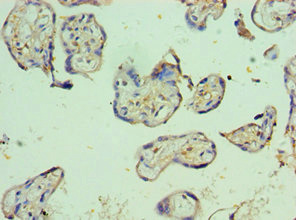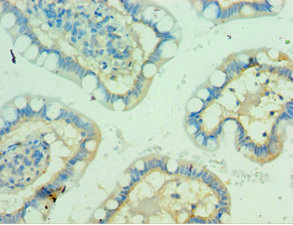
Immunohistochemistry of paraffin-embedded human placenta tissue using CSB-PA019093ESR2HU at dilution of 1:100
PVR Antibody
CSB-PA019093ESR2HU
ApplicationsELISA, ImmunoHistoChemistry
Product group Antibodies
ReactivityHuman
TargetPVR
Overview
- SupplierCusabio
- Product NamePVR Antibody
- Delivery Days Customer20
- ApplicationsELISA, ImmunoHistoChemistry
- CertificationResearch Use Only
- ClonalityPolyclonal
- ConjugateUnconjugated
- Gene ID5817
- Target namePVR
- Target descriptionPVR cell adhesion molecule
- Target synonymsCD155; HVED; NECL5; Necl-5; nectin-like protein 5; poliovirus receptor; PVS; TAGE4
- HostRabbit
- IsotypeIgG
- Protein IDP15151
- Protein NamePoliovirus receptor
- Scientific DescriptionMediates NK cell adhesion and triggers NK cell effector functions. Binds two different NK cell receptors: CD96 and CD226. These interactions accumulates at the cell-cell contact site, leading to the formation of a mature immunological synapse between NK cell and target cell. This may trigger adhesion and secretion of lytic granules and IFN-gamma and activate cytoxicity of activated NK cells. May also promote NK cell-target cell modular exchange, and PVR transfer to the NK cell. This transfer is more important in some tumor cells expressing a lot of PVR, and may trigger fratricide NK cell activation, providing tumors with a mechanism of immunoevasion. Plays a role in mediating tumor cell invasion and migration. Serves as a receptor for poliovirus attachment to target cells. May play a role in axonal transport of poliovirus, by targeting virion-PVR-containing endocytic vesicles to the microtubular network through interaction with DYNLT1. This interaction would drive the virus-containing vesicle to the axonal retrograde transport.2 Publications
- ReactivityHuman
- Storage Instruction-20°C or -80°C
- UNSPSC12352203

